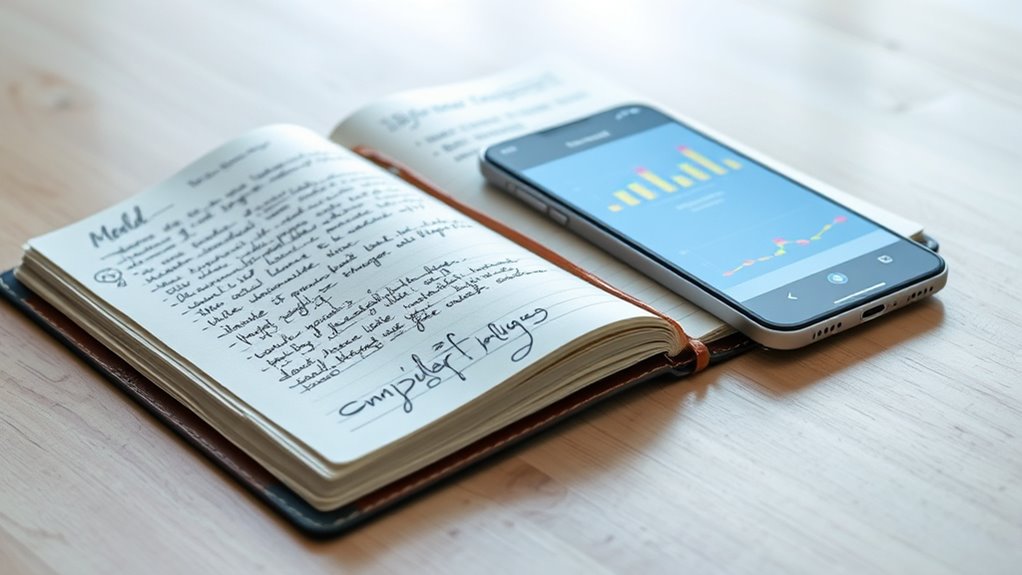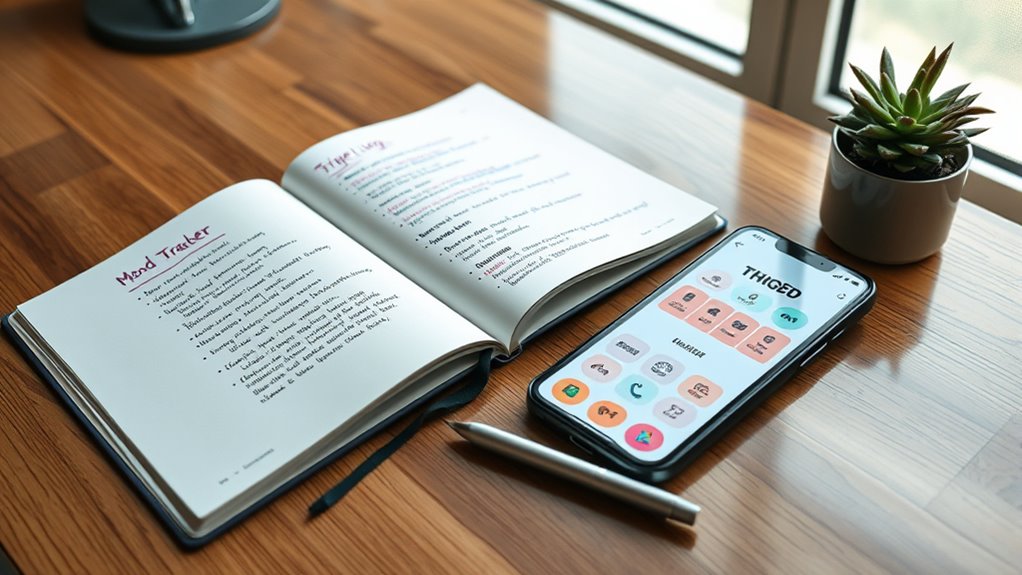Tracking your triggers is a simple yet powerful way to understand your emotional reactions and habits. Use a notebook, app, or spreadsheet to record situations, feelings, and thoughts as they happen. Look for patterns in recurring environments or emotional states that lead to certain behaviors. This awareness helps you develop targeted coping strategies and healthier alternatives. Keep at it consistently, and you’ll discover valuable insights that can transform how you manage your responses—continue to uncover more effective techniques.
Key Takeaways
- Use a consistent method like a notebook or app to record triggers immediately when they occur.
- Be specific about feelings, situations, and contexts to identify recurring patterns effectively.
- Track triggers regularly to recognize emotional, environmental, or thought-based causes of habits.
- Analyze recorded data to pinpoint high-impact triggers and develop targeted coping strategies.
- Incorporate healthier alternatives and proactive plans based on your trigger patterns for lasting change.

Have you ever wondered what sparks your unwanted habits or emotional reactions? Understanding your triggers is essential if you want to change behavior patterns that hold you back. The good news is that tracking your triggers is a simple yet powerful system that can make a real difference. It’s about becoming more aware of the situations, feelings, and thoughts that set off your habits, so you can start addressing them directly. When you start paying close attention to these triggers, you gain valuable insights into what causes you to act in ways you’d like to change. This awareness isn’t about judgment but about understanding; it’s about learning what’s behind your reactions instead of just reacting automatically.
The first step is to create a dedicated space where you record your triggers as they happen. You can use a notebook, a mobile app, or even a simple spreadsheet—whatever makes it easiest for you. When you notice yourself falling into an unwanted habit or feeling a surge of emotion, jot down the time, what you were doing, who you were with, and how you felt. Be specific. For example, instead of writing “stressed,” note whether you felt anxious, overwhelmed, or irritable. Over time, you’ll start to see patterns emerge. Maybe you notice that certain places, like your office or social gatherings, tend to trigger stress or impulsive actions. Or perhaps specific emotions like boredom or loneliness often precede your habits. Recognizing these patterns helps you understand your unique triggers, rather than assuming they’re the same as someone else’s.
Tracking also helps you identify the frequency and severity of your reactions. You might realize that some triggers lead to minor discomfort, while others cause intense urges that are harder to resist. When you know which triggers hit hardest, you can develop targeted strategies to cope more effectively. For example, if boredom triggers snacking or mindless scrolling, you might plan engaging activities to replace those moments. If stress triggers emotional outbursts, you can practice relaxation techniques before those feelings intensify. The act of recording your triggers also creates a sense of accountability. It’s easier to resist a habit when you’re aware of what’s prompting it, and tracking keeps you honest with yourself. Additionally, incorporating knowledge about Juice Recipes and Mixes can inspire healthier alternatives or soothing drinks during challenging moments, supporting your efforts to manage triggers more effectively.
Frequently Asked Questions
How Long Should I Track My Triggers Before Seeing Results?
You should track your triggers for at least two to four weeks to start noticing patterns and insights. Consistency is key, so make sure you record every incident without skipping days. As you gather more data, you’ll see clearer links between triggers and your reactions. Keep an open mind and review your logs regularly, and you’ll begin to understand what influences your behavior and how to manage it more effectively.
Can Trigger Tracking Help With Emotional Regulation?
Yes, trigger tracking can definitely help with emotional regulation. When you identify specific triggers, you gain insight into your emotional patterns and responses. This awareness allows you to develop strategies to manage your emotions more effectively. By consistently tracking your triggers, you learn to recognize early signs of emotional escalation and intervene before they become overwhelming. Over time, this practice boosts your self-control and helps you respond to situations more calmly and intentionally.
What Tools Are Best for Tracking Triggers Effectively?
Think of your trigger tracking as planting seeds for emotional clarity. The best tools are simple yet powerful—journals, mood-tracking apps, or a dedicated notebook. Use apps like Daylio or Moodpath to log feelings quickly, or jot down notes during the day. These tools act as your compass, guiding you through emotional storms and helping you notice patterns, making it easier to manage your reactions and stay centered.
How Do I Identify Hidden or Subconscious Triggers?
You can identify hidden or subconscious triggers by paying close attention to your emotional and physical reactions in various situations. Keep a journal to note moments when you feel sudden stress, anger, or sadness without clear reasons. Reflect on these entries regularly, looking for patterns or common themes. Over time, you’ll notice subtle cues or recurring feelings that point to underlying triggers you might not be fully aware of.
Is Trigger Tracking Useful for Managing Chronic Health Conditions?
Think of trigger tracking as your personal compass, guiding you through the maze of chronic health management. It’s incredibly useful because it helps you spot patterns and identify what worsens your symptoms. By actively monitoring your reactions and habits, you can make informed decisions, adjust your routines, and feel more in control. This simple system empowers you to navigate your health journey with awareness, leading to better symptom management and improved well-being.
Conclusion
By tracking your triggers, you’re like a detective unraveling the mystery of your habits, uncovering clues that lead to change. Remember, even Hercules faced challenges before mastering his strength. Stay consistent, and each insight brings you closer to victory. With this simple system, you’re forging your own hero’s journey—one step at a time. Embrace the process, and watch as you transform your struggles into triumphs, just like legends of old.









